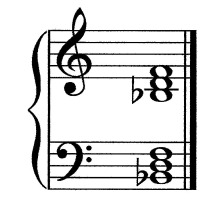

Now, you may be wondering (or have wondered in the past): what’s the difference between a chord vs note? Well, the key concept behind a chord versus a note is that all three of these notes are played together instead of one at a time. If you have a keyboard or a piano in front of you, go ahead and try arranging your fingers and playing the chord. Your middle finger (3) is going to go on D, which is the third white key to the right of Bb, and your pinkie finger (5) is going to go on F, two white keys to the right of D. Your thumb, finger number 1, is going to go on B flat, which is the black key labeled below. To play a Bb chord, you’ll need fingers 1, 3, and 5. Since B is on a white key, most of the time, the key to the left is going to be black: that’s B flat (Bb), the root of the chord we’re learning today. For now, all you need to know is that to flat a note (in this case, B), it’s going to make it one black or white key back. Since it’s the only one we’ll need today, we’ll save the theory behind sharps and flats for another day. Some of you may have noticed that one of the black keys (above) is labeled. The keyboard below has the keys labeled for you with each note that we saw on the staff to give you an idea of how they connect: Let’s look at a keyboard to figure out where everything goes.

The thumb will be 1, the pointer finger 2, and so on, as seen below. It’s possible to play pieces well with the incorrect fingering, but it makes it harder as you progress.įingering starts with assigning each finger a number the numbers are the same on both hands, though this diagram is for the right hand only. To learn how to play a B flat (Bb) chord on the piano, everyone is going to start with their right hand, and then we’ll move on to the left.įingering is an important part of learning the piano, and it gives you a strong foundation for learning harder pieces.


 0 kommentar(er)
0 kommentar(er)
